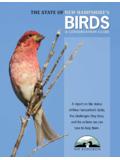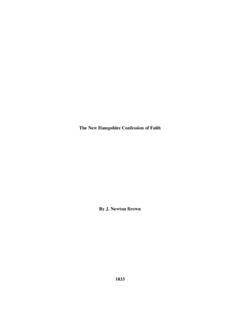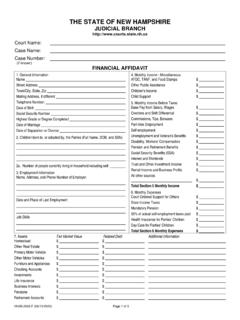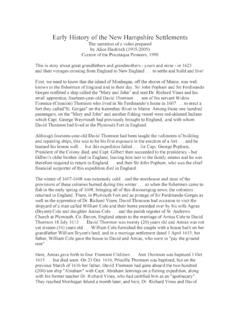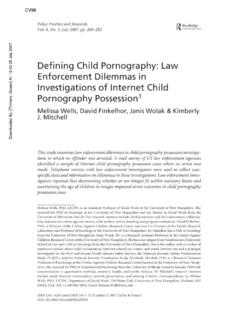Transcription of Ground Snow Loads for New Hampshire - SENH
1 Ground Snow Loadsfor New HampshireWayne Tobiasson, James Buska, Alan Greatorex,February 2002 Jeff Tirey, Joel Fisher, and Steve JohnsonApproved for public release; distribution is unlimited. ERDC/CRREL TR-02-6 Cold Regions Researchand Engineering LaboratoryUS Army Corpsof Engineers Engineer Research andDevelopment CenterAbstract:Because of New Hampshire s hillylandscape, mapped values of Ground snow loadare not available for much of its area. We con-ducted snow load case studies to establishground snow Loads for a specific elevation in eachof the 259 towns in the state. That work was doneby three researchers and three structural engi-neers practicing in New Hampshire . While ourmethods of analysis varied somewhat, our resultsHow to get copies of ERDC technical publications:Department of Defense personnel and contractors may order reports through the Defense Technical Informa-tion Center:DTIC-BR SUITE 09448725 JOHN J KINGMAN RDFT BELVOIR VA 22060-6218 Telephone (800) 225-3842E-mail others may order reports through the National Technical Information Service:NTIS5285 PORT ROYAL RDSPRINGFIELD VA 22161 Telephone (703) 487-4650(703) 487-4639 (TDD for the hearing-impaired)E-mail information on all aspects of the Engineer Research and Development Center, visit our WorldWide Web site: comparable and the feedback we receivedfrom each other was quite valuable.
2 We also es-tablished a statewide elevation adjustment factorto transfer our snow load answers to other eleva-tions in each town. We suggest that similar stud-ies be conducted for other places in the UnitedStates where mapped values are not availablebecause of extreme local variations in Ground project has been a collaborative effort by the Structural Engineers of New Hampshire (SENH) and the Cold Regions Research and Engineering Laboratory (CRREL). US Army Corpsof Engineers Cold Regions Research &Engineering LaboratoryTechnical ReportERDC/CRREL TR-02-6 Prepared forOFFICE OF THE CHIEF OF ENGINEERSA pproved for public release; distribution is Snow Loadsfor New HampshireWayne Tobiasson, James Buska, Alan Greatorex,February 2002 Jeff Tirey, Joel Fisher, and Steve JohnsonUS Army Corpsof Engineers Engineer Research andDevelopment Centerii ERDC/CRREL TR-02-6 PREFACE This report was prepared by Wayne Tobiasson, , Research Civil Engi-neer (retired volunteer); James Buska, Research Civil Engineer.
3 And Alan Greatorex, Civil Engineering Technician of the Civil and Infrastructure Engi-neering Branch, Cold Regions Research and Engineering Laboratory (CRREL), Engineering Research and Development Center (ERDC), Army Corps of Engineers; and Jeff Tirey, , Structural Engineer; Joel Fisher, , Structural Engineer; and Steve Johnson, , Structural Engineer of Structural Engineers of New Hampshire Inc. (SENH). SENH is a non-profit professional association of structural engineers. Mr. Tirey is a principal of Tirey and Associates, of Littleton, NH; Mr. Fisher is a Manager, Structural Engineering, with Rist-Frost-Shumway Engineering of Laconia, NH; and Mr. Johnson is a Structural Engineer with Vanasse Hangen Brustlin Inc. of Bedford, NH. The authors thank George Blaisdell and Kathy Jones of CRREL for their reviews and comments on this report. This work was sponsored by the Army Corps of Engineers, the New Hampshire Building Code Officials Association, and the following New Hamp-shire structural engineering firms: Altus Engineering CLD Consulting Engineers Inc.
4 Emanuel Engineering Civil Engineers Group Hayashi Corporation Hoyle, Tanner and Associates JSN Associates McFarland-Johnson, Inc. Rist-Frost-Shumway Engineering SEA Consultants Stahlman Engineering Corporation Ground Snow Loads for New Hampshire iii Steffensen Engineering Tirey and Associates, About 60% of the work reported here was done on a volunteer basis. Renee Melendy and Arlene Phillips of CRREL compiled our case study answers in such a way that the author of each value and comment was unknown to the rest of us. The contents of this report are not to be used for advertising or promotional purposes. Citation of brand names does not constitute an official endorsement or approval of the use of such commercial products. iv ERDC/CRREL TR-02-6 CONTENTS Preface.
5 Ii Contents .. iv 1 Introduction .. 1 2 Establishing case study locations .. 6 3 Case study forms and guidelines .. 8 4 Various ways of arriving at answers .. 12 5 pg/pmax ratio .. 15 6 Intercept 17 7 Elevation adjustment factor .. 17 8 One load and one elevation correction factor for all of New Hampshire ? .. 18 9 Modification of case study tabulations and plots .. 19 10 Time devoted to the analysis .. 19 11 Findings .. 21 12 Conclusions .. 27 13 Recommendations .. 29 Literature cited .. 30 Appendix A. Coordinates of the geographical center and elevation information for each town in New 31 Appendix B. Guidelines on conducting case 37 ILLUSTRATIONS Figure 1. State of New Hampshire , showing town and county boundaries overlaid with the Ground snow load information in ASCE 7 .. 3 Figure 2. State of New Hampshire , showing stations where Ground snow load information is available for our three categories of towns.. 4 Figure 3.
6 Case study data tabulation for the town of Salisbury .. 9 Figure 4. Case study plots for the town of Salisbury .. 10 Figure 5. Nearest-values plot for Randolph, showing the adverse effect of Mt. Washington on the slope of the line of best fit .. 11 Figure 6. Log-normal probability plots for Waterville Valley, Milford, and 16 Figure 7. Elevation adjustment factor for the 236 highest-quality stations used in our analyses .. 18 Figure 8. Location of each New Hampshire town presented in Table 1.. 22 TABLES Table 1. Ground snow load (pg) at a specific elevation for all New Hampshire 23 Ground Snow Loads for New Hampshire WAYNE TOBIASSON, JAMES BUSKA, ALAN GREATOREX, JEFF TIREY, JOEL FISHER, AND STEVE JOHNSON 1 INTRODUCTION Determining appropriate snow Loads is a critical step in the design of structures in cold regions. Because of New Hampshire s hilly terrain, there are extreme local variations in snow Loads , and mapped values are not available in codes and standards for much of the state.
7 In such areas the selection of an appropriate snow load is left to the authority having jurisdiction. In most cases such authorities know little about snow Loads . Errors and inconsistencies result, which jeopardize public safety. These problems prompted CRREL and Structural Engineers of New Hampshire Inc. (SENH) to work together to generate snow load values for all locations in the state except for a few high-elevation places. For the design of structures in the United States, the primary resource document used by various building codes is American Society of Civil Engineers (ASCE) Standard 7, Minimum design Loads for buildings and other structures (ASCE 2000). It is commonly referred to as ASCE 7-98. It is revised and reissued every few years. The next edition will be referred to as ASCE 7-02. The first step in determining design snow Loads is to determine the Ground snow load at the place of interest. ASCE 7-98 contains a map of the United States overlaid with that information.
8 That map was made by Tobiasson and Greatorex of CRREL using data from 204 first-order National Weather Service (NWS) stations, where snow depths and snow Loads are measured frequently, and data from about 11,000 other NWS co-op stations, where only the depth of snow on the Ground is measured frequently. In some areas, extreme local variations in Ground snow Loads preclude mapping at a national scale. In those areas the national map contains the designation CS instead of a value. CS indicates that case studies are required to establish Ground snow Loads in these areas. In other areas the values presented on the map only apply up to certain elevations, which are shown in parentheses. Case studies are also required above such elevations. 2 ERDC/CRREL TR-02-6 Figure 1 presents the information from the ASCE 7-98 map for New Hampshire , showing county and town boundaries.
9 The word town, as used here, represents both incorporated towns and other unincorporated places. In total these 259 towns cover all of New Hampshire s land. The zoned values in Figure 1 are Ground snow Loads with a 2% annual probability of being exceeded ( , they represent a 50-year mean recurrence interval). As can be seen in Figure 1, all of New Hampshire is either in a CS area or the zoned values have elevation limits (the numbers in parentheses) above which case studies are needed. Thus, case studies are needed to determine Ground snow Loads for many structures in New Hampshire . Section , Ground Snow Loads , pg, of ASCE 7-98 requires that, in these situations, Ground snow Loads shall be based on an extreme value statistical analysis of data available in the vicinity of the site using the value with a 2% annual probability of being exceeded (50-year mean recurrence interval). At CRREL a methodology has been developed to conduct snow load case studies.
10 It and the data used are described in the paper, Database and methodology for conducting site specific snow load case studies for the United States, which was presented at the Third International Conference on Snow Engineering (Tobiasson and Greatorex 1997). That database also contains information from an additional 3300 locations across the United States where Ground snow Loads are measured a few times each winter by other agencies and companies. These are referred to as non-NWS stations. Figure 2 shows New Hampshire overlaid with town boundaries and the location of each station in the database used to perform case studies in New Hampshire . There are 1 NWS first-order station, 89 NWS co-op stations, and 91 non-NWS stations in New Hampshire . First-order stations in adjacent states within 50 miles (80 km) of the border and other stations within 25 miles (40 km) of the border were also used in our analysis. They are also shown in Figure 2.

